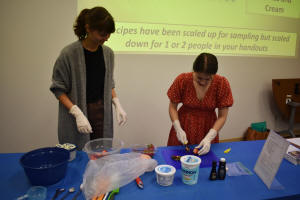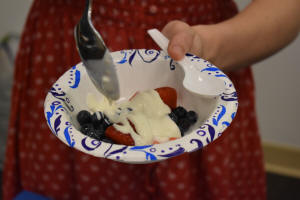|
Lincoln Memorial Hospital Hosts
“Cooking for 1 or 2” Cooking Class
 Send a link to a friend
Send a link to a friend
[August 24, 2023]
 Memorial
Wellness Center and the University of Illinois Extension
collaborated to bring a free cooking class to Lincoln on Wednesday
night. “Cooking for 1 or 2” was hosted by Lincoln Memorial Hospital
(LMH) and featured an informational presentation, an opportunity to
prepare recipes, and a sampling of delicious food at the end of the
seminar. Memorial
Wellness Center and the University of Illinois Extension
collaborated to bring a free cooking class to Lincoln on Wednesday
night. “Cooking for 1 or 2” was hosted by Lincoln Memorial Hospital
(LMH) and featured an informational presentation, an opportunity to
prepare recipes, and a sampling of delicious food at the end of the
seminar.

Jenna Smith, MPH, RDN, a Nutrition and Wellness
Educator with the University of Illinois Extension, conducted the
evening’s seminar at the invitation of Sarah Tierney, RN, BSN, CDCES,
who works with Memorial Wellness Center and LMH.
Smith began her presentation by asking the audience what the
potential problems were with cooking for only one or two people.
Audience members suggested food waste, the monotony of leftovers,
and finding the motivation to cook for only one person. Smith
concurred, stating that the USA wastes 25% of its food.
Smith pointed out that if we are inviting guests over for supper, we
do not wait until they show up to decide what we will do for the
meal, rather we plan. Even for one or two people, planning is the
key to avoiding the problems of cooking smaller meals. This issue
affects a sizable portion of the U.S. population as U.S. Census data
from 2019 indicates that 29% of U.S. households are individuals
living alone. That number is expected to keep rising.

Planning meals for one or two people begins with
taking inventory, picking recipes, and making lists of what is on
hand and what is needed. Consumers should also think about their
goals, such as adding more fruits and vegetables or reducing sodium,
as well as their budget. Smith suggested budgeting resources such as
the USDA’s Low-Cost Food Plan, which updates monthly to reflect the
fluctuating costs of food, and the Iowa State University Grocery
Budget Calculator.
Smith also explained that planning should include nutrition. Our
plates should primarily consist of vegetables and fruits, proteins
should be lean, and grains are best as whole grains. We should
choose calcium-rich foods and eat a variety of veggies.

Next, Smith provided some ways to address the common
problems of cooking for one or two, specifically, purchasing small
quantities, storing food efficiently, and keeping produce fresh.
Fresh fruit may be purchased by the piece and dry goods from bulk
bins to control quantity. Frozen veggies and fruits allow cooks to
take out only what is needed for the meal and put the remainder back
in the freezer. Canned fruit in 100% juice and low sodium canned
vegetables may also be good options for the pantry. Cooked whole
grains like rice, oatmeal, and barley can be frozen in single-serve
portions in a muffin tin. Bread freezes well, as do individual
portions of meat divided from larger packages. Non-fat dry milk can
be kept on hand for cooking, and it is important to note that eggs
can be stored for 3-5 weeks past their “sell by” date.
Smith offered important clarification about grocery dates. The “Sell
by” date on food means that the store must sell or remove that
product by that date. The “Use by” is a recommendation for consumers
about when the flavor or quality will be at their highest. The “Best
by” date is the last day that ensures peak quality. These three
dates do not mean that the food cannot be eaten past that date for
most foods. An “expiration date” means the items should not be used
after the indicated date on foods such as infant formula, baby food,
vitamins, medicines, yeast, and baking powder.
Freezing leftover portions of herbs, tomato paste, or sauce, broth,
and vegetables avoids food waste, as well as saving time with later
meals. Some cooks may want to make extra food when cooking,
specifically to make freezer meals for future use. As far as pantry
storage, do not store potatoes and onions together in order to
promote longer shelf-life for both. Consumers may also wish to note
that most shelf-stable canned goods are safe indefinitely as long as
the cans are not bulging, rusted, or dented.
After Smith’s presentation, she directed participants to four
workstations set up around the room. Each was equipped with the
directions, ingredients, and kitchen tools needed for preparing one
of the recipes included in the seminar handouts.


[to top of second column] |








The audience divided among the tables and prepared
Chinese Chicken Salad, White Chicken Chili, Summer Squash and Tomato
Stir Fry, and Berries and Cream. Everyone enjoyed tasting these
quick and easy recipes.


The recipe for Chinese Chicken Salad, useful for
using up leftover chicken, follows:
Chinese Chicken Salad
1 cup cooked, shredded chicken
1 cup shredded cabbage
½ cucumber, chopped
1 ½ cups romaine lettuce, torn
1 green onion, chopped
2 Tablespoons sliced almonds
1 Tablespoon sesame seeds
Dressing:
⅛ teaspoon black pepper
¼ teaspoon salt
1 Tablespoon sugar
2 Tablespoons apple cider vinegar
1 ½ teaspoons sesame oil
2 teaspoons olive oil
Directions:
Combine chicken, cabbage, cucumber, lettuce, and green onion in a
large bowl. In a small bowl whisk together all ingredients for
dressing. Toss salad with dressing until evenly coated. Top with
sliced almonds and sesame seeds. Yield: 4 servings
Nutrition Facts (per serving):
150 calories, 8 grams fat, 180 milligrams sodium, 7 grams
carbohydrates, 2 grams fiber, 13 grams protein
[Stephanie Hall]
 |